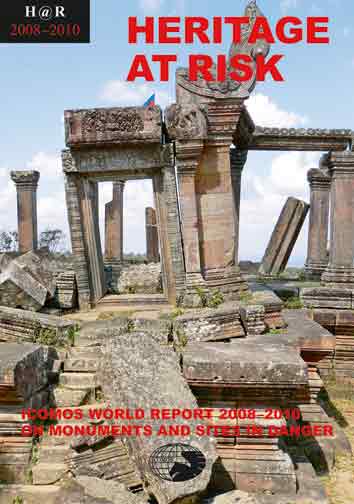Guidelines for the Heritage@Risk Report
Heritage at Risk: ICOMOS World Report on Monuments and Sites in Danger
Heritage at Risk: ICOMOS World Report on Monuments and Sites in Danger is produced regularly to assist in understanding and monitoring the health/state of cultural heritage through the active contribution of reports by the ICOMOS network of members, National and International Scientific Committees.
It is complementary to existing ICOMOS initiatives such as:
- ICORP - the International Committee on Risk Preparedness which has been established to develop professional guidance on risk management as an integral part of conservation practice; and
- ICBS - the International Committee of the Blue Shield of which ICOMOS is a founding partner, which co-ordinates response actions between the major cultural heritage NGOs to emergencies and disasters affecting heritage.
Who is it for?
The Report is not only conceived as a vehicle to share, among professional colleagues, information about risks to cultural heritage and to identify emerging conservation solutions. It is also a vehicle for analysing trends affecting cultural heritage worldwide that are of interest to a much broader audience.
It is distributed to international organisations and media by the ICOMOS Secretariat, with appropriate media releases. National and Scientific Committees are responsible for its distribution to relevant media and national organisations, government and key stakeholders.
How is it produced?
The production of the Report is the responsibility of a Taskforce of at least three mandated members of the ICOMOS Board. The Taskforce ensures the production of the report, with the support of an editorial board and a project manager who is responsible for:
- collecting and collating reports and illustrations
- editing reports to ensure the quality of the language (refer Styleguide) without changing the meaning or facts of the report.
- co-ordinating communication with the Taskforce and other individuals or groups as appropriate (e.g. the ICOMOS Secretariat Director)
- overseeing the print production.
The Report will be produced regularly.
Language
The common language used for the publication of the Report is English. There may also be versions in the other languages of ICOMOS (accompanied by Abstracts in English).
Content
The Report is an ICOMOS product. It includes all reports produced through a consultative process, and authorised by ICOMOS National and/or International Scientific Committees. It can also include authorised reports submitted by partner organisations of ICOMOS.
Where there is no National ICOMOS Committee, an ICOMOS member may submit a report that can be considered for publication by the Taskforce. In exceptional cases individual reports from other professional specialists will be considered after review by a member of the ICOMOS Board.
Where a report is received which is not from the National Committee, it will be submitted to the relevant National ICOMOS Committee for comment, before being considered for publication by the Taskforce.
What material is expected?
All National and International Scientific Committees are responsible for submission of a report for each Report in due time and according to the following general guidelines. The format and content may depend on circumstances relevant to a committee in a given year. The following is intended, therefore, as a general guideline and not a prescribed formula.
Length: Usually reports are around 3 pages of text
Format: Electronic only - in either word or rtf format (newspaper articles can be scanned as PDF documents).
Content:
- Progress report on matters reported in the previous year's publication
- Analysis and overview of threats to heritage in the reporting year
- Illustrative case studies (2 or 3)
- Solutions to these threats, ideas that are emerging
- Heritage is broadly defined: buildings, sites, landscapes, neighbourhoods, parks, traditional activities and values etc.
- Threats are also broad in their scope, and include human-made threats (from development to armed conflict) and natural events.
References: Necessary references or sources should be included at the end of the text
Contact Information: Contact for further information (e.g. email/web address) should be included
Illustrations:
- A selection of images (2-3 minimum) from which some examples could be chosen
- Preferably hard copy, Black & White prints or well-contrasted colour pictures (photocopies of illustrations cannot be used)
- Saved as .JPG files, not .TIF
- All illustrations to be accompanied by captions
- If authority to reproduce is required this must be provided with the illustration
- Photographic credits must be provided
- Tables, graphs etc. should be suitable to be reproduced in ONE colour
Authorship: Indicate if authorship is to be accredited to an individual, the committee, or individual/s on behalf of the committee
Deadlines
To ensure that the Heritage at Risk Report is current and relevant, all material must be submitted to the Editor three months before its publication.
Further Information & Queries
All queries should be directed through the ICOMOS Secretariat.
Prepared by Sheridan Burke, Dinu Bumbaru, Jane Harrington & Michael Petzet
(Dubrovnik - October 2001, updated December 2015)





